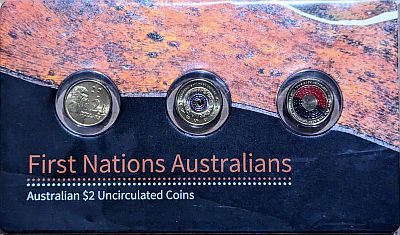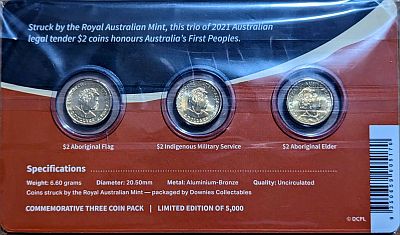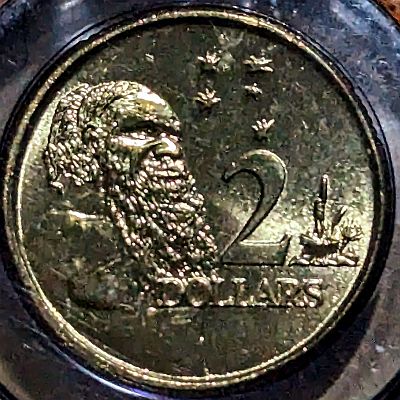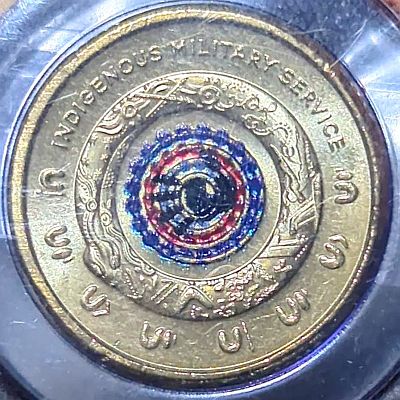A set of three indigenous themed coins

Downies Collectibles, an Australian coin dealer, produced a presentation card containing the three First Nations Australians-themed coins produced by the Royal Australian mint in 2021. The three coins are:
- Regular circulation $2 coin featuring a First Nations Eldar
- Indigenous Military Service $2 coin
- 50th anniversary of the Aboriginal flag $2 coin

First, a note regarding terms: The AIATSIS website states: “‘Indigenous Australian’ is a very general term that covers two very distinct cultural groups: Aboriginal and Torres Strait Islander peoples. Many Aboriginal and Torres Strait Islander people do not like to be referred to as ‘Indigenous’ because it is considered too generic and can be applied to all indigenous peoples of the world. There is a growing preference for First Nations Australians as a more encompassing term”. As such, I will endeavour to use the term First Nations Australians (or First Nations). In some cases, I have left original names such as which are commonly applied elsewhere, or when quoting.
The obverse of each coin features the Jody Clark portrait of Queen Elizabeth II used from 2019 – 2023. The commemorative coins have room under the portrait for the denomination. The regular circulation coin has the portrait extending to the bottom of the coin as the denomination is written on the reverse.

The regular circulation coin, produced since 1988 features Gwoya Jungarai (sometimes spelled Tjungurrayi).
Known as “One Pound Jimmy”, he was a survivor of the Coniston Massacre in the Northern Territory in 1928, when police killed at least 31 Warlpiri men, women and children.
This was a time when chief protectors were appointed to “watch over the interests” of First Nations people, and to “smooth the dying pillow” for a race of people who had been brought to the edge of extinction.
The image of Gwoya Jungarai came from a photo of him in 1935. This was used on a postage stamp in 1950, making him the first living Australian to be so featured.
The 1988 and 1989 coins include the initials of the designer, Horst Hahne, on the chest of Gwoya. Some sites claim these are rare and valuable. This is simply not true. The Royal Australian Mint produced 160 million $2 coins when they were introduced in 1988 and 31 million in 1989. This is more than the mintage of the next ten years combined.

The second coin included is the Indigenous Military Service $2 coin. Designed by Aboriginal Artist and Kalkadoon woman Chern’ee Sutton, the coin is the first coloured coin commemorating First Nations people.
Similar to Native Americans, First Nations Australians were not all one “nation”. There are over 250 distinct indigenous nations across Australia. Kalkadoon is an indigenous nation in the Mount Isa area of Queensland).
When unveiling the coin, Royal Australian Mint CEO, Leigh Gordon said: “Having served in every conflict and commitment involving Australian defence contingents since Federation, including, but not limited to, Gallipoli, Kokoda and Vietnam, the strength of Indigenous service has been a constant throughout Australian history.”
The design of the coin is rich with Indigenous and military symbols that represent and acknowledge Indigenous Australia’s longstanding tradition of serving in the military.
Ms Sutton said that a black handprint in the centre surrounded by three rows of dots in the colours of the Defence Forces Tri-Service Flag represents the 120-year contribution of Indigenous military men and women.
I noticed that the handprint on mine is pointing to the left, compared to directly up on the Royal Australian Mint site (and on Ms Sutton’s site). Investigating this, it turns out that as there are very few coloured $2 coins with a specific orientation of the colour. Many have a solid ring of one colour, or a pattern which can be any orientation (eg if this coin had the dots but not the handprint). So the colour may be randomly rotated on any particular example.

The third coin features the Aboriginal Flag, designed by artist Harold Thomas in 1970. The Aboriginal Flag $2 coin design is credited to him. The flag’s design consists of a coloured rectangle divided in half horizontally. The top half of the flag is black to symbolise Aboriginal people. The red in the lower half stands for the earth and the colour of ochre, which has ceremonial significance. The circle of yellow in the centre of the flag represents the sun.
The flag was first raised on 9 July 1971. In 1995, the Aboriginal flag was recognised by the Australian Government as an official ‘Flag of Australia’ under the Flags Act 1953.
Like the military service coin, the flag colours on this coin may be randomly rotated. On mint sets and carded coins from the mint, these were specifically oriented. On the 2 million circulation and 250,000 mint rolls the orientation of the colour is random. As with the military service coin, this is just how they were made, they are not error coins. If you are looking to purchase one, do not be fooled into paying extra thinking you have a mint mistake!
Three very important coins to Australia, and I was torn on whether to write each up separately, or as a single post. Do let me know in the comments whether you like the combination of related pieces like this, or whether each should have its own post.


Leave a Reply